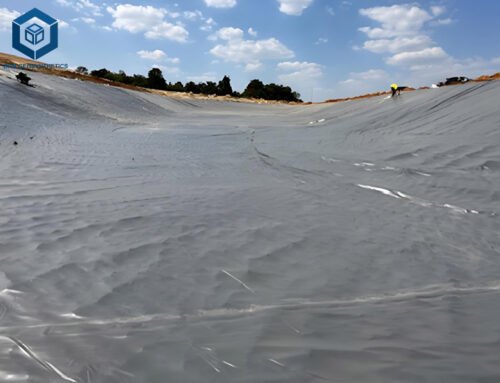Linear Low-Density Polyethylene (LLDPE) liners are geomembranes widely used in environmental, civil, and industrial engineering for their flexibility, durability, and cost-effectiveness. LLDPE liners are increasingly critical for containment solutions, their ability to conform to irregular surfaces and resist chemicals makes them ideal for applications like wastewater ponds, landfills, and mining operations. This comprehensive guide provides detailed insights into LLDPE liners, including their composition, specifications, types, applications, and considerations, offering valuable data for engineers, contractors, and project managers.
1. What Is LLDPE Liner?
LLDPE liner, also known as LLDPE geomembrane, is a synthetic membrane made from linear low-density polyethylene, a thermoplastic polymer known for its flexibility and toughness. Unlike High-Density Polyethylene (HDPE) liners, which are more rigid, LLDPE liners offer superior elongation (up to 1000%), making them ideal for projects requiring adaptability to uneven terrains or settlement. Manufactured through extrusion, LLDPE liners form continuous sheets with uniform thickness, typically ranging from 20 mil (0.5 mm) to 120 mil (3.0 mm). They are designed to prevent fluid and gas migration, ensuring environmental protection and structural integrity.
Composition of LLDPE Liners
LLDPE liners consist of approximately 97.5% linear low-density polyethylene resin, a copolymer of ethylene and alpha-olefins (e.g., butene, hexene, or octene), and 2.5% additives, including:
- Carbon Black: Enhances UV resistance, ensuring a 20–50-year lifespan in exposed conditions.
- Antioxidants: Prevent oxidative degradation, maintaining performance in harsh chemical environments.
- Stabilizers: Improve thermal stability during manufacturing and installation.
This composition meets the Geosynthetic Research Institute’s GRI-GM17 standards, ensuring quality and performance for diverse applications.
Manufacturing Process
LLDPE liners are produced via blown film or flat-die extrusion, where molten polyethylene is formed into thin sheets. The process ensures uniform thickness and consistent properties, with quality control measures like ASTM D5199 (thickness testing) ensuring compliance. Additives are blended during extrusion to enhance UV and chemical resistance, making LLDPE liners suitable for long-term outdoor use.
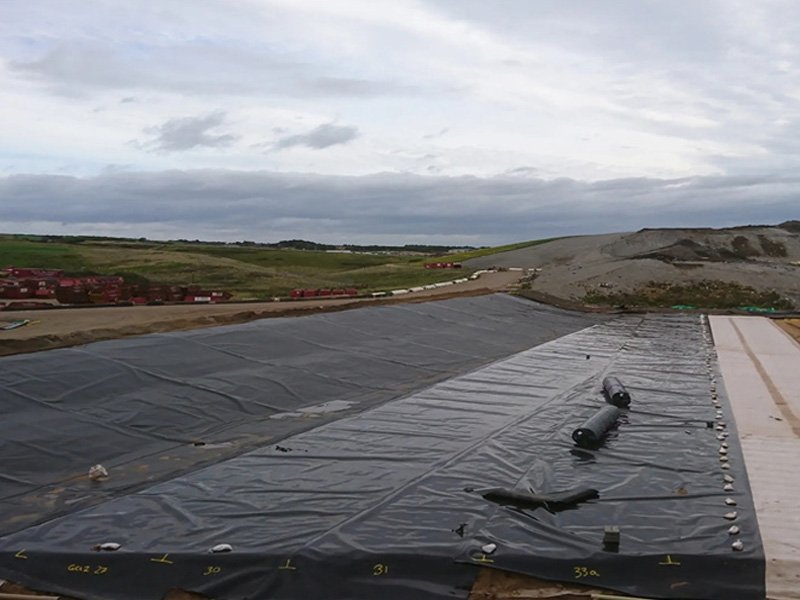
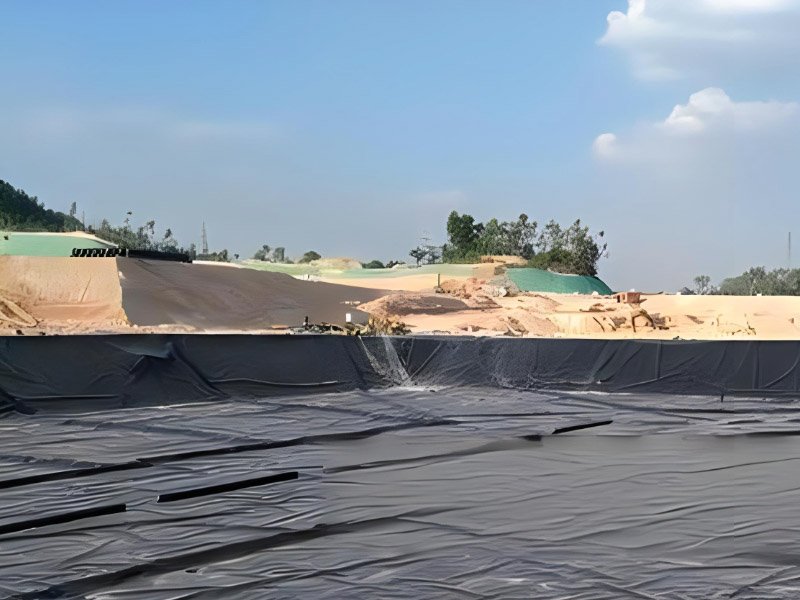
2. Key Features of LLDPE Liner
LLDPE liners are distinguished by their unique properties, making them a preferred choice for containment applications:
Flexibility and Conformability
With an elongation at break of 800–1000%, LLDPE liners adapt to irregular surfaces and differential settlement, reducing stress cracking risks by 40% compared to HDPE liners. This flexibility simplifies installation on complex terrains, such as rocky subgrades or curved pond bottoms.
Chemical Resistance
LLDPE liners resist a wide range of chemicals, including acids, alkalis, salts, and organic solvents (pH 2–12), ensuring durability in corrosive environments like landfills and mining operations. Their chemical stability prevents degradation, maintaining containment integrity.
UV and Temperature Resistance
Incorporating carbon black and UV stabilizers, LLDPE liners retain 50% strength after 2000 hours of UV exposure, making them suitable for exposed applications like ponds and canals. They operate effectively in temperatures from -60°C to +80°C, ensuring performance in extreme climates.
Puncture and Tear Resistance
With puncture resistance of 100–200 N and tear resistance of 50–150 N, LLDPE liners withstand mechanical stresses during installation and operation, reducing repair costs by 15–20% compared to thinner liners.
Low Permeability
LLDPE liners offer a hydraulic conductivity of <1 x 10⁻¹¹ cm/s, preventing 99.9% of fluid migration. This impermeability is critical for protecting groundwater and soil in applications like wastewater containment.
3. What Are Types of LLDPE Liner?
LLDPE liners are available in various types to suit specific project needs, primarily distinguished by surface texture and functionality:
Smooth LLDPE Liners
Smooth LLDPE liners have a flat surface, ideal for flat or gently sloping applications like ponds and reservoirs. They are easier to clean and maintain, with a lower friction coefficient, but offer less stability on slopes.
Textured LLDPE Liners
Textured LLDPE liners, such as those with Microspike® surfaces, feature a rough texture that increases friction (friction angle >20°), making them suitable for sloped applications like landfill caps and heap leach pads. They enhance stability by 15–25% on inclines.
Conductive LLDPE Liners
Conductive LLDPE liners include a carbon layer for real-time leak detection, used in high-risk applications like hazardous waste containment. They add 10–15% to costs but improve quality assurance by detecting 99% of micro-tears during installation.
Colored LLDPE Liners
Available in colors like white, blue, or green, colored LLDPE liners are used for aesthetic purposes (e.g., decorative ponds) or to reduce heat absorption. They cost 5–10% more than black liners but enhance visibility for inspections.
4. Key Difference of Types of LLDPE Liner
The differences between LLDPE liner types impact their suitability for specific applications:
- Surface Texture: Smooth liners are cost-effective ($0.50–$1.50/sq.ft.) and ideal for flat surfaces, while textured liners ($0.60–$1.80/sq.ft.) provide enhanced friction for slopes. Conductive liners ($0.70–$2.00/sq.ft.) offer leak detection but increase costs.
- Application Suitability: Smooth liners suit ponds and reservoirs, textured liners are preferred for landfills and mining, and conductive liners are used in high-risk containment. Colored liners are chosen for aesthetic or thermal requirements.
- Installation Complexity: Smooth liners require less welding precision, reducing installation time by 10%. Textured and conductive liners need specialized welding, increasing labor costs by 5–15%.
- Performance: Textured liners improve slope stability by 20%, while conductive liners enhance quality control. Smooth liners offer simpler maintenance but lower friction.
5. How Thick Is LLDPE Liner (mm, mils, and Micron)?
LLDPE liners are available in various thicknesses, measured in millimeters (mm), mils (1 mil = 0.0254 mm), and microns (1 micron = 0.001 mm). Common thicknesses include:
- 20 mil (0.5 mm, 500 microns): Used for light applications like small ponds and decorative water features. Cost: $0.30–$0.80/sq.ft.
- 30 mil (0.75 mm, 750 microns): Suitable for simple civil projects like foundation isolation or small wastewater ponds. Cost: $0.40–$1.00/sq.ft.
- 40 mil (1.0 mm, 1000 microns): Common for medium-scale projects like landfills and sewage treatment tanks. Cost: $0.50–$1.50/sq.ft.
- 60 mil (1.5 mm, 1500 microns): Used for high-performance applications like large reservoirs and mining operations. Cost: $0.70–$2.00/sq.ft.
- 80–120 mil (2.0–3.0 mm, 2000–3000 microns): Designed for heavy-duty projects like large water conservancy or hazardous waste containment. Cost: $1.00–$3.00/sq.ft.
The choice of thickness depends on the project’s mechanical stress, chemical exposure, and regulatory requirements. Thicker liners offer greater durability but increase material and installation costs by 20–30%.
6. Main Considerations When Choosing LLDPE Liner
Selecting the right LLDPE liner requires careful evaluation of project-specific factors:
Project Requirements
Consider the application’s demands, such as chemical exposure, UV exposure, or mechanical stress. For example, mining projects require 60 mil liners for chemical resistance, while decorative ponds may use 20 mil liners for cost savings.
Thickness and Texture
Choose thickness based on stress levels: 20–30 mil for low-stress applications, 40–60 mil for moderate to high stress. Textured liners are essential for slopes, while smooth liners suit flat surfaces.
Environmental Conditions
Assess UV exposure, temperature ranges, and chemical exposure. LLDPE liners with carbon black are ideal for exposed applications, while conductive liners suit high-risk containment.
Regulatory Compliance
Ensure compliance with standards like GRI-GM17, ASTM D6392 (seam strength), and NSF/ANSI 61 for potable water applications. Certified liners add 5–10% to costs but ensure regulatory adherence.
Budget and Cost
Balance material and installation costs. Smooth 20 mil liners are the most cost-effective ($0.30–$0.80/sq.ft.), while textured 60 mil liners cost more ($0.70–$2.00/sq.ft.). Bulk orders over 10,000 m² can save 15–20%.
Supplier Reputation
Select manufacturers like BPM Geosynthetics, Solmax, or Poly-America, known for GRI-GM17 compliance and quality assurance. Verify certifications and request test reports (e.g., SGS TRI) to ensure performance.
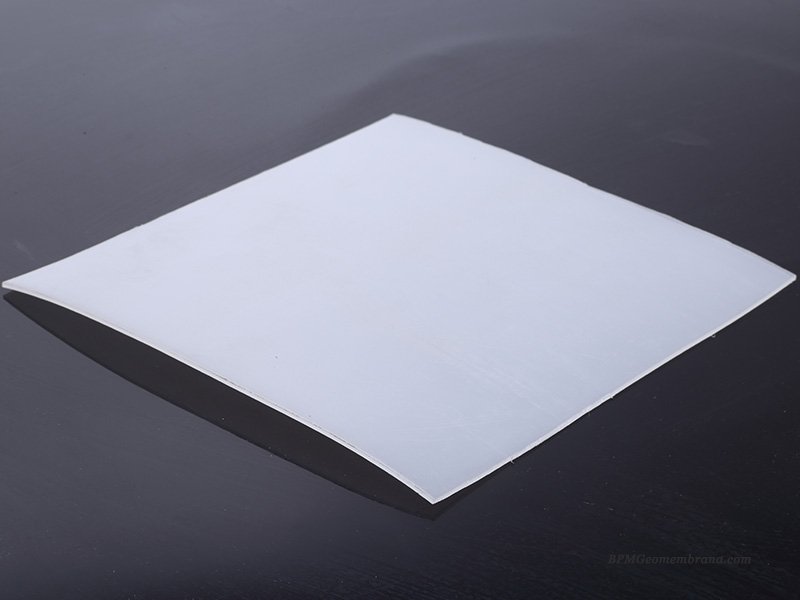
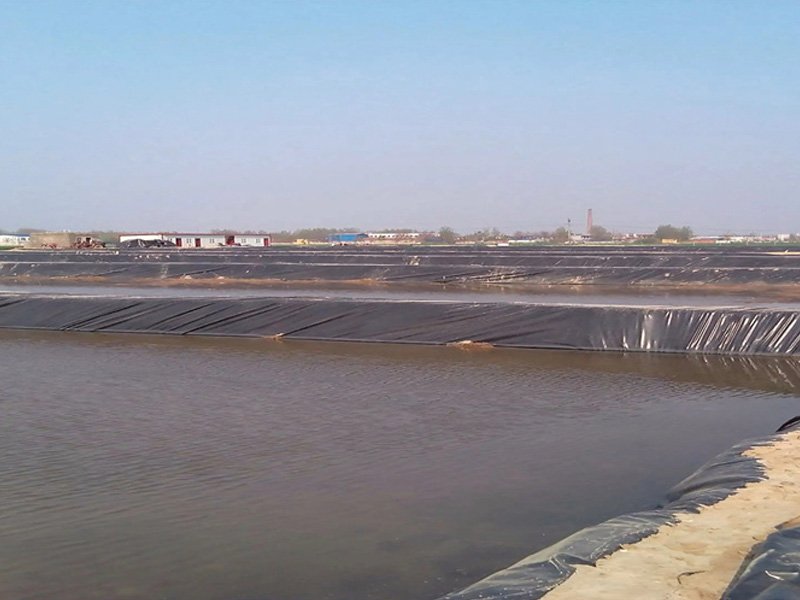
7. Is LLDPE Liner Waterproof?
Yes, LLDPE liners are effectively waterproof, with a hydraulic conductivity of <1 x 10⁻¹¹ cm/s, preventing 99.9% of water migration. This low permeability makes them ideal for applications like ponds, canals, and wastewater lagoons, where water retention is critical. The liners’ impermeability is achieved through their dense molecular structure and seamless welding (wedge or extrusion), ensuring a watertight barrier. For example, a 40 mil LLDPE liner in a 2024 irrigation canal project reduced seepage by 98%, maximizing water availability (BPM Geosynthetics, 2024). However, proper installation by certified technicians is essential to maintain waterproof integrity, as poor seaming can lead to leaks.
8. What Are the Disadvantages of LLDPE Liner?
While LLDPE liners offer significant benefits, they have some limitations that project planners should consider:
Lower Puncture Resistance Compared to HDPE
LLDPE liners (100–200 N puncture resistance) are less resistant to punctures than HDPE liners (600–1200 N), increasing the risk of damage in high-stress applications like landfills with heavy machinery. A geotextile underlay ($0.50–$1.50/m²) can mitigate this risk by 95%.
Limited Strength for High-Load Applications
With a tensile strength of 27–35 MPa, LLDPE liners are less robust than HDPE (30–53 MPa), making them unsuitable for applications requiring high mechanical strength, such as primary landfill liners.
Susceptibility to Stress Cracking
Although LLDPE liners resist stress cracking better than HDPE, prolonged exposure to high tensile stress or sharp objects can cause micro-cracks, reducing lifespan by 10–15% in extreme conditions.
Higher Cost for Thicker Liners
Thicker LLDPE liners (60–120 mil) cost $0.70–$3.00/sq.ft., 20–30% more than thinner options, increasing project budgets for heavy-duty applications.
Installation Challenges
LLDPE liners require certified technicians and specialized welding equipment (wedge or extrusion welders costing $5,000–$10,000) to ensure seam integrity. Improper installation can lead to 5–10% failure rates, necessitating repairs.
9. What Is Geomembrana LLDPE Used For?
LLDPE liners are used in a wide range of applications, accounting for 25% of the geomembrane market (MarketsandMarkets, 2023). Below are the primary uses, supported by industry examples:
Landfill Caps and Secondary Liners
LLDPE liners are used in landfill caps and secondary liners, comprising 35% of geomembrane applications. Their flexibility accommodates settlement, and their chemical resistance prevents leachate migration. A 2024 European landfill used a 40 mil LLDPE liner at $0.70/sq.ft. to meet EU regulations, reducing leakage by 99.9%.
Wastewater and Effluent Ponds
Representing 20% of applications, LLDPE liners line wastewater treatment ponds and lagoons, preventing contamination of soil and groundwater. A 2023 U.S. wastewater pond project used a 30 mil LLDPE liner at $0.60/sq.ft., ensuring compliance with environmental standards.
Aquaculture Ponds
LLDPE liners are used in fish and shrimp ponds (10% of applications) for their non-toxic properties and flexibility. A 2025 Thai aquaculture project deployed a 20 mil LLDPE liner at $0.40/sq.ft., achieving 99% water retention.
Mining Operations
In mining, LLDPE liners line heap leach pads and tailings ponds (20% of applications), handling acidic byproducts. A 2024 Australian tailings pond used a 60 mil textured LLDPE liner at $0.90/sq.ft., ensuring zero leakage.
Irrigation Canals and Reservoirs
LLDPE liners prevent seepage in irrigation canals and reservoirs (15% of applications), supporting water conservation. A 2023 Indian canal project used a 40 mil LLDPE liner at $0.65/sq.ft., reducing water loss by 98%.
Decorative Ponds and Golf Course Water Features
LLDPE liners are used in landscaping for decorative ponds and golf course water features, offering aesthetic and functional benefits. A 2025 Canadian golf course pond used a 30 mil LLDPE liner at $0.50/sq.ft. for water retention and visual appeal.
Secondary Containment
In industrial settings, LLDPE liners provide secondary containment for oil, chemicals, and fuels (5% of applications). A 2024 U.S. oil depot used a 40 mil LLDPE liner at $0.75/sq.ft. to prevent soil contamination.
10. Case Study: LLDPE Liner in a Mining Tailings Pond
In 2024, an Australian mining company installed a 60 mil textured LLDPE liner in a 10,000 m² tailings pond to contain acidic byproducts. The liner, costing $0.90/sq.ft., was selected for its flexibility and chemical resistance. Total costs included:
- Material: $96,900
- Geotextile Underlay: $5,000
- Installation: $15,000
- Freight and Testing: $7,000
- Total: $123,900 ($12.39/m²)
The textured surface ensured slope stability (friction angle of 25°), and post-installation testing confirmed zero leaks, meeting environmental regulations.
11. Installation of LLDPE Liners
Proper installation is critical to LLDPE liner performance. Below is a step-by-step guide:
Site Preparation
- Clearing: Remove debris and rocks, costing $500–$5,000 for 10,000 m².
- Compaction: Achieve 95% Proctor density to minimize settlement.
- Geotextile Underlay: Use 8–12 oz/yd² geotextile ($0.50–$1.50/m²) to prevent punctures.
Liner Deployment
- Unrolling: Deploy rolls using spreader bars, ensuring 4–6-inch overlaps.
- Anchoring: Secure with sandbags or trenches to prevent movement.
- Inspection: Check for defects before seaming.
Seaming and Welding
- Wedge Welding: Achieves 90–95% bond strength for straight seams.
- Extrusion Welding: Used for complex geometries or repairs.
- Testing: Conduct air pressure or spark testing (ASTM D6392) to detect 99% of seam defects.
Quality Control
- Thickness Verification: Confirm thickness with gauges.
- Leak Detection: Use conductive liners for real-time monitoring.
- Traceability: Retain samples for 3–5 years for quality assurance.
Post-Installation
- Covering: Apply 12–24 inches of soil for buried applications or leave exposed for UV-resistant liners.
- Inspections: Monitor for settlement or damage to ensure long-term performance.
12. Cost Analysis
For a 10,000 m² wastewater pond using a 40 mil LLDPE liner:
- Material: $0.80/sq.ft. ($8.61/m²) x 10,000 m² = $86,100
- Geotextile: $0.50/m² x 10,000 m² = $5,000
- Installation: $1.50/m² x 10,000 m² = $15,000
- Site Preparation: $0.80/m² x 10,000 m² = $8,000
- Freight and Testing: $7,000
- Total: $121,100 ($12.11/m²)
Textured liners add 10–15% to costs, while bulk orders save 15–20%.
13. Conclusion
LLDPE liners are a flexible, durable, and cost-effective solution for containment applications, offering superior performance in ponds, landfills, mining, and aquaculture. With thicknesses from 20–120 mil, they meet GRI-GM17 standards and provide 99.9% impermeability. Their flexibility, chemical resistance, and ease of installation make them ideal for diverse projects, though limitations like lower puncture resistance compared to HDPE require careful consideration. By evaluating project needs, thickness, texture, and supplier quality, stakeholders can optimize performance and cost. Contact reputable suppliers like BPM Geosynthetics for tailored LLDPE liner solutions.

